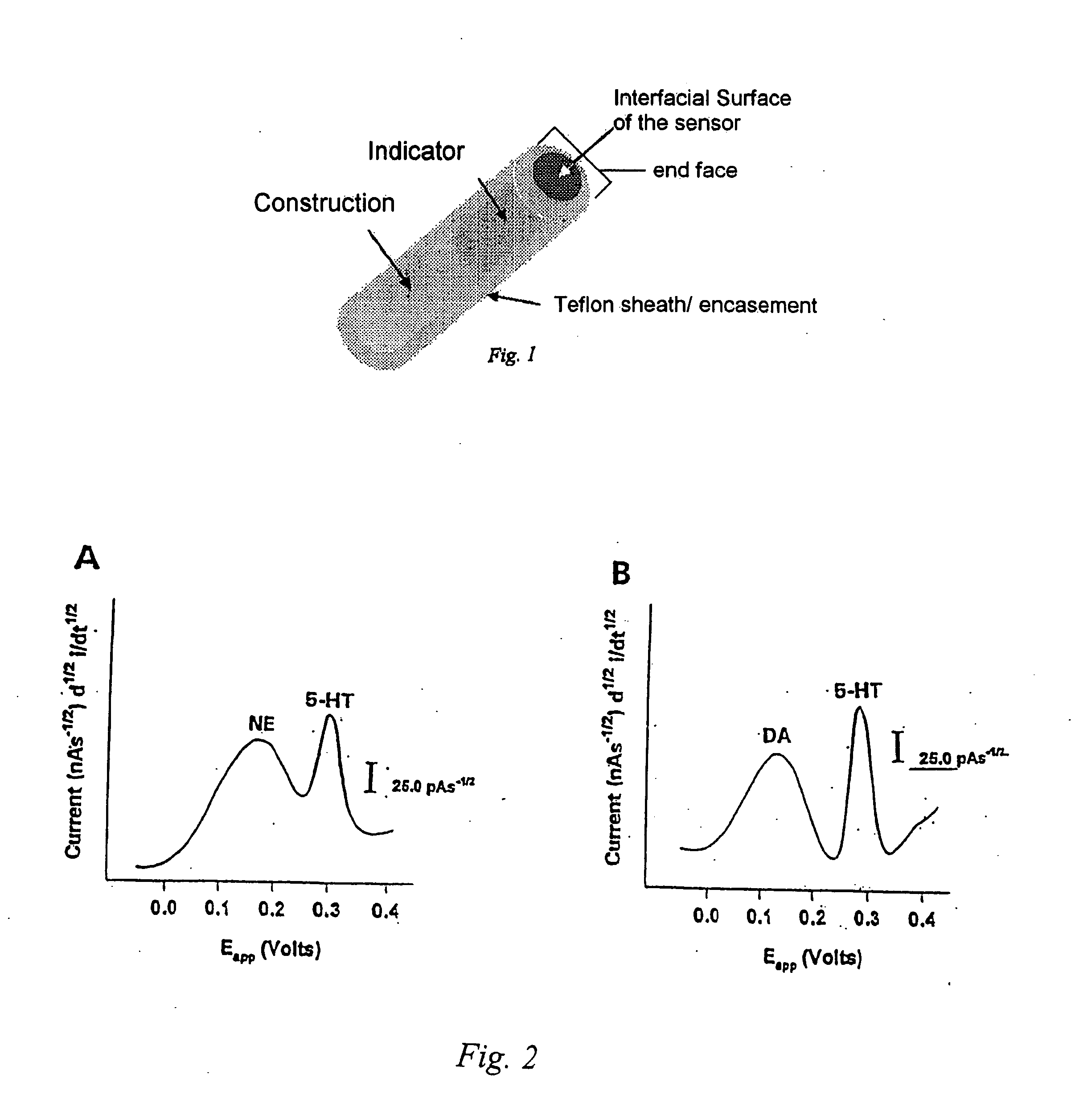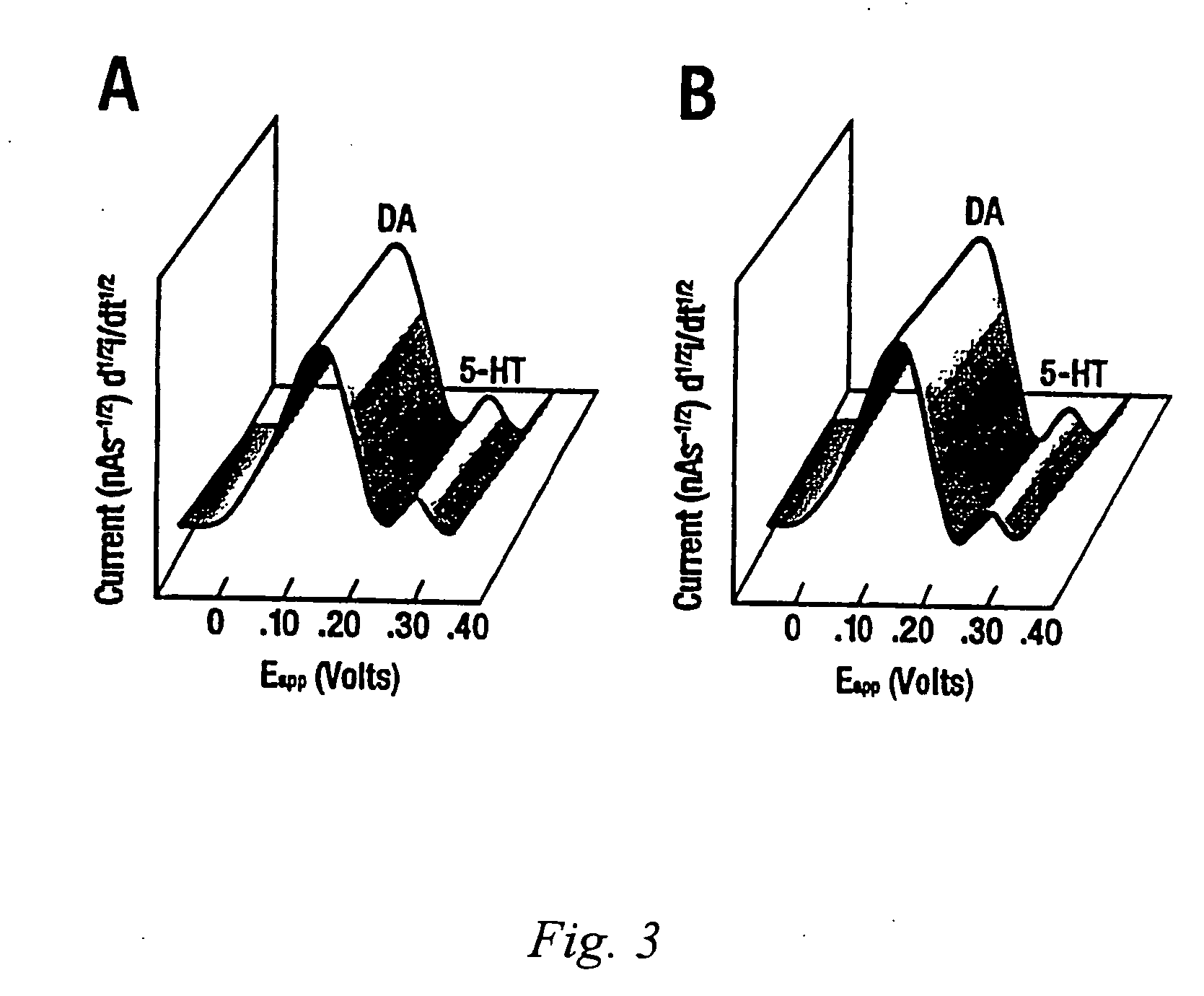Identification, diagnosis, and treatment of neuropathologies, neurotoxicities, tumors, and brain and spinal cord injuries using electrodes with microvoltammetry
a microvoltameter and neurotoxicology technology, applied in the direction of instruments, catheters, material electrochemical variables, etc., can solve the problems of insufficient linear diffusion, insufficient in vitro analysis techniques, and criticized techniques
- Summary
- Abstract
- Description
- Claims
- Application Information
AI Technical Summary
Benefits of technology
Problems solved by technology
Method used
Image
Examples
example 1
[0117] BRODERICK PROBE® sensors may have different formulations, e.g., cerebrosides and oleic acid; however, for these studies, the laurate sensor was used because it reaches steady state quickly. Although these sensors can be manufactured at any size or any length, for these studies, the laurate sensors comprising an indicator and construction. The construction portion was made of a polytetrafluoroethylene (PTFE; Teflon®) coated stainless steel wire having a diameter of 150 μm (Medwire, Mount Vernon, N.Y.). The coating was gently pulled 500 μm over the stainless steel tip to form a well. The well, or indicator portion, was packed with a graphite paste modified with (99+%) lauric acid. The graphite / lauric acid (Ultra Carbon, Bay City Mich.) (Sigma, St. Louis, Mo.) was admixed with mineral oil (a.k.a. Nujol) containing DL-alpha tocopherol as a stabilizer (Plough Inc., Memphis, Tenn.).
[0118] The reference microelectrode was constructed by electrochemically coating silver wire (Medwir...
example 2
Human Epilepsy
[0121] Fourteen patients who had temporal lobectomies for intractable seizures were studied. Patients underwent intraoperative surgery within the same time period and were studied in order of time, within the same time period. Patients were classified as having mesial temporal lobe epilepsy if pathologic examination of the resected temporal lobe revealed severe hippocampal neuronal loss and gliosis and if examination of the neocortex revealed no other etiology for the patient's epilepsy. Nine patients were classified as mesial temporal lobe epilepsy based on these features. Five patients were classified as having neocortical temporal lobe epilepsy based on the lack of hippocampal atrophy on magnetic resonance imaging (MRI) and demonstration of seizure onset in temporal neocortex during chronic intracranial EEG study with lateral temporal subdural grid electrodes and multiple baso-mesial temporal subdural strip electrodes.
[0122]FIG. 1 shows a schematic diagram of a Br...
example 3
Human Epilepsy
[0132] Significant differences in the monoamine signatures from the hippocampal subparcellations in patients with MTLE and NTLE have been observed. The alveus (hippocampal white matter) contains both efferent fibers from hippocampus that form the fornix and afferent pathways connecting entorhinal cortex and the CA1 region of the hippocampus. The neurochemistry of the alveus in patients with MTLE and NTLE was studied to determine whether similar neurotransmitter alterations exist.
[0133] Microvoltammetry with Broderick probe stearic acid electrodes was used to detect norepinephrine (NE), dopamine (DA), ascorbic acid (AA), and serotonin (5-HT) in resected temporal lobes of 9 MTLE and 4 NTLE patients with temporal lobe epilepsy. Neurotransmitters were detected in separate signals within the same recording within seconds in alveus by experimentally derived oxidative potentials, determined in vitro in Ringers Lactate or PO4 buffer. Ag / AgCl reference and stainless steel aux...
PUM
| Property | Measurement | Unit |
|---|---|---|
| Mass | aaaaa | aaaaa |
| Concentration | aaaaa | aaaaa |
| Shape | aaaaa | aaaaa |
Abstract
Description
Claims
Application Information
 Login to View More
Login to View More - R&D
- Intellectual Property
- Life Sciences
- Materials
- Tech Scout
- Unparalleled Data Quality
- Higher Quality Content
- 60% Fewer Hallucinations
Browse by: Latest US Patents, China's latest patents, Technical Efficacy Thesaurus, Application Domain, Technology Topic, Popular Technical Reports.
© 2025 PatSnap. All rights reserved.Legal|Privacy policy|Modern Slavery Act Transparency Statement|Sitemap|About US| Contact US: help@patsnap.com



